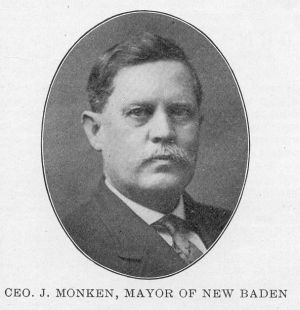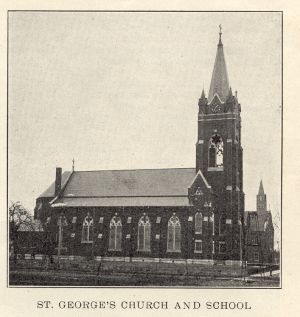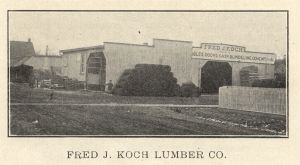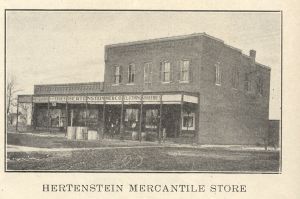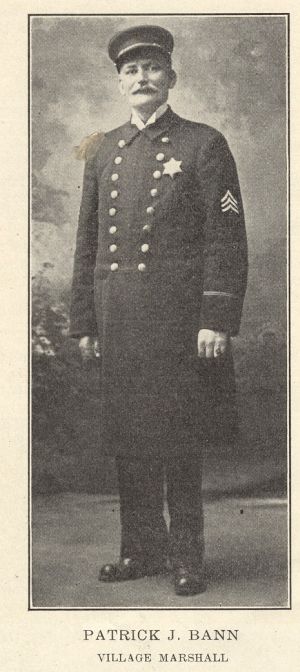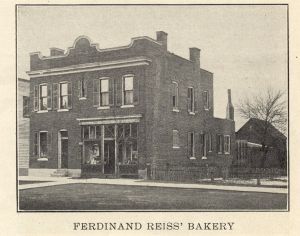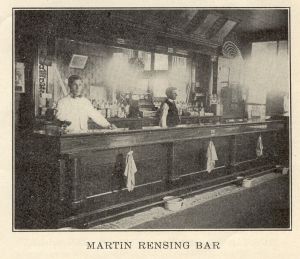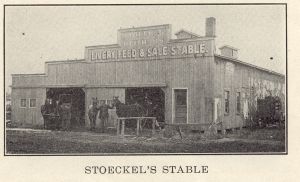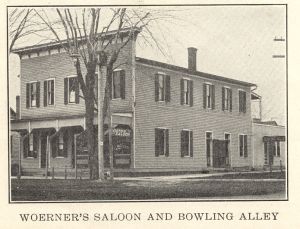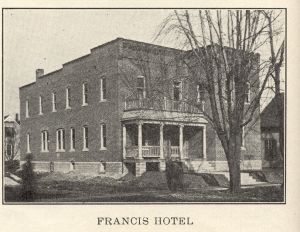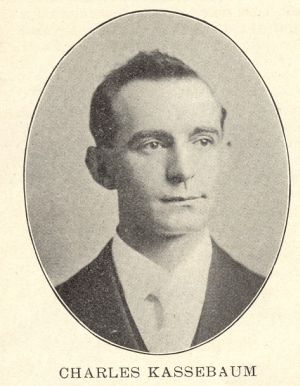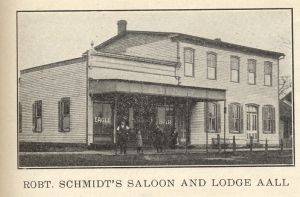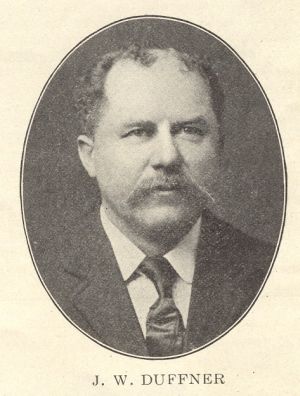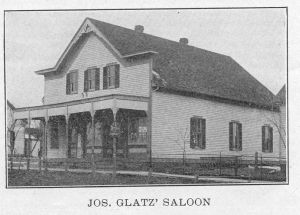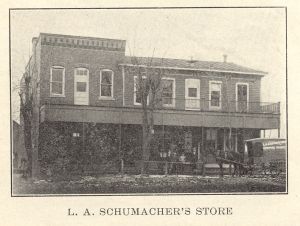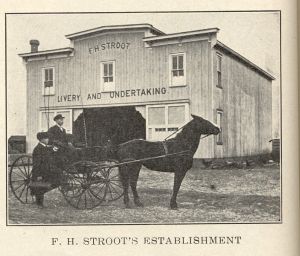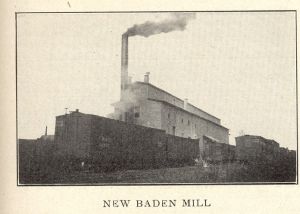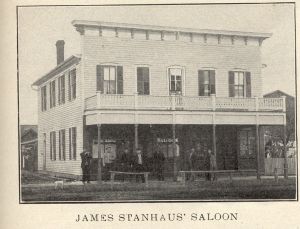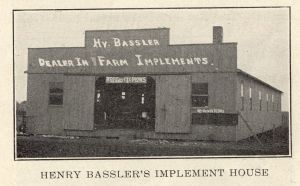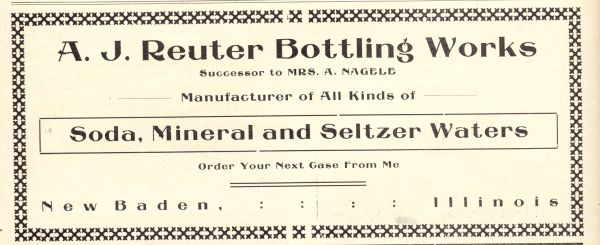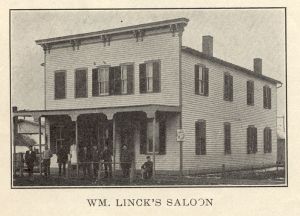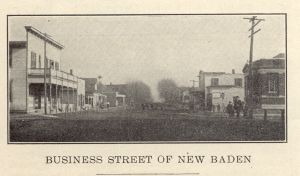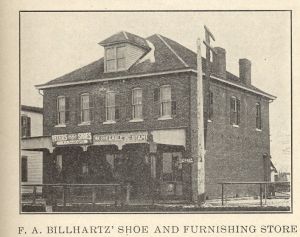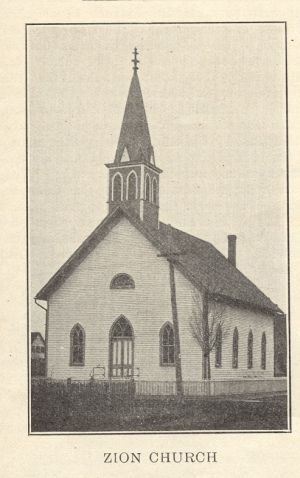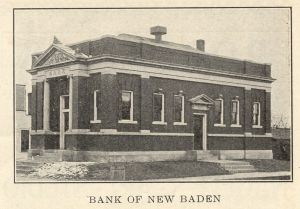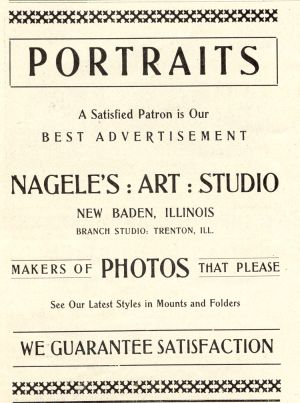|
Page 60 |
|
|
New Baden is one of the thriving cities of Clinton County. It has a population of approximately 1,400 and is one of the best little cities in the county, located on the Southern Railway, 32 miles east of East St. Louis. Up to the year 1896 New Baden was a small place. During that year, or to be more exact, on Wednesday, May 27th, a cyclone struck New Baden and literally wiped the town off of the map. Prior to the cyclone New Baden had about sixty houses and its streets were nicely shaded with maple trees. On the evening of May 27th, 1896, at 6:15, the terrific cyclone, the most destructive in the history of the county, swept over the little village, demolishing thirty-one buildings, entailing a total loss to the owners. Many other buildings were slightly wrecked, while others were robbed of chimneys, porches, etc. The aggregate loss amounted to over $50,000. The newspaper accounts at the time were not overdrawn. The half only has been told of the suffering, distress and sorrow in this village. The pen cannot describe, words cannot impart, the artist cannot paint scenes picturing to us the unfortunate conditions of the victims of the storm on that fatal night. It is beyond the power of man to describe the terror and destructive force of a cyclone and the suffering that is left in its path. To fully comprehend the magnitude of the devastation of this nature’s ravager, it is necessary to be on the ground personally, and with your own eyes see the sad sights of happy homes swept away, and with them all the furniture, clothing and belongings; to witness in person the bodies of men, women and children, whose lives were blotted out, in an instant, or to extricate the wounded, bleeding and suffering, from their pinioned positions; or to pacify the wailing and moaning who almost miraculously escaped. Such a picture would have presented itself in your eyes had you been in New Baden on that fatal night. Darkness, and rain in torrents, set in after the storm, and the suffering lay there without shelter. The work of relief was begun immediately, at which the neighboring towns lent a strong and willing hand. To the volunteers from Trenton, who braved the dangerous road on that disagreeable night, and did such noble work in searching for the injured and transporting them to places of shelter, thanks was duly extended. Following is a list of those who were killed and those who died from injuries received during the cyclone: Peter KRAUS |
Willie
RUST The New Baden of 1896 and 1913 is vastly different. Today the city has some of the finest buildings in the county. Many of them, and the principal business houses, are substantially built of brick. Among the business concerns are numbered many who were in the little village at the time of the cyclone. Today the city has one mill, one mine, one bank, four general stores, all well stocked; three groceries, one bakery, eight saloons, three gent’s furnishing stores, two barber shops, one lumber yard, one hardware concern, one tin shop, one saddlery shop, one large and commodious hotel, one undertaker, one livery stable, one implement house, one drug store, one picture show, one real estate firm, one confectionery store, one jeweler, two butchers, one restaurant, two doctors, one dentist, one veterinary surgeon and several smaller places of business. The city also has three churches: One Catholic, one Lutheran, and one Methodist. There are two schools: One Catholic parochial and one public school. The city also has three societies. There are two church and one singing society. New Baden is also well represented with lodges, several being instituted. The public school has an enrollment of 205 and the Catholic school about 175. There are 14 pupils in the High school department of the city public school. The members of the Board of Education include the following well known men of New Baden: Dr. E. G. SCHMITT, President; Fred HEITHAUS, Secretary; Robert SCHMIDT, Henry SINGLER, Ed HARPSTREITH, Henry GREDE and Joseph WIELWEIN, Trustees. Ten grades are taught in the school, including English and American Literature, Untied States and Ancient History, advanced Grammar, Algebra, Rhetoric, Botany, Zoology, Physical Geography and Commercial Geography. The faculty includes the following: Z. C. CARSON, Principal; Anna E. OHLSON, Joseph KIEFER, Cora GRIEMEYER, Vio HARPER and Frances MIENER, Teachers. The city administration consists of the following citizens of New Baden: George J. MONKEN,
Mayor The Aldermen are the following: Wm. STOECKEL, J. W. DUFFNER, Hy. PETER, Adam VICK, Joe POLKER and Wm. BIENE. The Mayor George J. MONKEN, the present Mayor of New Baden, was elected for the first time in 1909. He succeeded himself in 1911 and again in 1913. The two latter times he had no opportunity to speak of. He is one of the best |
|
Page 61 |
|
|
known men in the county and was born in Columbia in 1865. He moved with his family to New Baden in 1869, and has been a resident of Clinton County ever since. In 1891 he became connected with the New Baden Milling Company,
at that time a small grist mill. He is one of the directors of the mill at the present time, and is also interested in several other enterprises in the city and county. During his residence in New Baden he has held many public offices. He was Township Supervisor for seven years, Police Magistrate for four year and filled other minor offices during the years during the years he has claimed New Baden as his home. He was married in 1888 to Miss Louise BUTZOW and to this union were born five boys and one girl. Two of the sons are living in St. Louis, and the rest in New Baden with the parents. Mr. MONKEN is one of the livest boosters of the city and is ever ready to foster any movement that will be of benefit to the little city. It was during his administration as Mayor that the city has gained in population and wealth considerably more than during previous administrations. He has also been an advocate of good government and an able politician. St. George’s Parish A Monument to Catholicity The first Catholic settlers of the present town of New Baden and vicinity mostly emigrated from the Grand Duchey of Baden (Germany). They attended to their religious duties at Germantown and Highland, and later on at Damiansville, Trenton and Mascoutah. In the year 1893 two acres of ground were bought from Mr. Val HEINZMANN for the purpose of erecting a new church for the Catholics of this thriving and progressive city and its surrounding territory. Subsequently, in July of the same year Rev. Gehard TOENNIES, up to that time assistant at Murphysboro, Ill., was appointed assistant at Germantown, from whence he organized the new parish at New Baden. On November 11th, 1894, Rev. TOENNIES celebrated the first Holy Mass in the town hall. For the two years following he attended the new parish, as a mission parish, from Germantown. Finally, on November 1st, 1896 Rev. TOENNIES located at New Baden as the first permanent pastor. The first building, serving at the same time for a church, school and sister’s dwelling was erected in 1895, at a cost of about $7,500.00. It is built of brick with a good rock foundation, two stories high, the upper story being |
used for church proper, the lower for school rooms and sister’s dwelling as stated. The congregation, when this church was built, consisted of thirty-six families. As the years rolled by the town increased and with it the congregation, thus in 1907, the first church having become entirely too small, a new and larger one was built at a cost of $52,000.00. It is a beautiful structure in Gothic style, built of solid brick, with an all concrete foundation. Its seating capacity is approximately 560. Mr. Victor KLUTHO, a prominent architect of St. Louis, Mo., was the designer and architect. St. George’s parish at the present time numbers about 170 families, with a school attendance of 175 children approximately. The members of this congregation are mostly native Americans of German descent. Church and school are heated by steam, the parochial residence by hot water system. The parish in 1894 purchased ground for a cemetery. It comprises one acre of land and is situated on the main road leading to the city of New Baden. It may be interesting for the readers of this volume to learn a little of the history of the zealous pastor of St. George’s. Rev. Gerhard TOENNIES was born at Germantown, Ill., on the 12th of November, 1864. After graduating from the schools of his native town he studied classics at Teutopolis, Ill., and later Philosophy and Theology at St. Francis Seminary, St. Francis, Wis. He was ordained priest on June 24th, 1891, in St. Boniface Church, Germantown, Ill. In July of the same year, he was
appointed assistant at St. Andrew’s Church, Murphysboro, Ill., and served in this capacity until July 12, 1894, when he was sent as assistant to Germantown, and at the same time was intrusted with the pastorate of New Baden as a mission. On November 1st, 1896, he appointed as resident pastor of New Baden, in which he is serving at the time. Fred J. KOCH The above named, a partner in the firm of KOCH Brothers, dealers in lumber, hardware and sheet metal, has been a resident of New Baden for many years. He was born within a few miles of the city in 1870, his birthplace having been Germantown. The firm of KOCH Brothers has been in business for the past nine years and was started by A. J. KOCH. Later on H.N. KOCH bought out |
|
Page 62 |
|
|
the interests of A. J. and a few months later John C. one of the present partners, became a member of the firm. Fred J. has been connected with the firm for the past four ears. The firm handles everything in the hardware line: lighting plants and pneumatic water are installed. They also do electric wiring and sell electric supplies. They also do plumbing and steam fitting, and manufacture sheet metal work of all kinds. Around the corner from the hardware store is the lumber yard which is managed by Fred J. KOCH and Henry WESTERFELHOUS. A $10,000 stock of lumber and building material of all kinds is carried in stock; it is the only lumber yard in the city. In connection with lumber the yard has a complete stock of woven wire picket fencing which is manufactured by
the firm. They also handle roofing and tiling. Fred J. KOCH is the present member of the Illinois Legislature from that district, having been re-elected in 1912. He is a Democrat and one of the most able men in the State Legislature. He was born in Germantown in 1870 and was married in 1898. He has five children living and one dead, those living are four girls and one boy. Besides being connected with the several business enterprises in New Baden, he is also President of the Savings Bank at Germantown. Mr. KOCH was the organizer of the present lighting plant in New Baden, which was built at a cost of $13,500.00. The lights were turned on for the first time November 28th, 1912. The plant supplies electricity for all the homes and business concerns in the city. There are forty street lights controlled from the main office, which is located immediately west of the mill. The company
was organized to erect the plant and it was then leased to the city for a period of ten years, after which time it becomes the property of the city as a municipal plant. It is known as the New Baden Light and Power Company. The street lights are of the Tungsten variety and afford ample light for the streets. The present officers of the company are: Fred J. KOCH, President; F. A. BILLHARTZ, |
Secretary, and John F. ENGELKE, Treasure. The Directors are: L. A. SCHUMACHER, William LINCK and the above officers. Mr. KOCH is one of the most energetic business men in the city, and that he will succeed is a foregone conclusion. He is interested in anything that is for the good of the town. HERTENSTEIN Mercantile Co. The above is the largest general mercantile establishment in the city and was started many yeas ago by R. HERTENSTEIN. To be exact, the store as started in 1880, in a small way, in a little frame building. At that time the stock was very small, and only a line of groceries, dry goods and furnishing was carried. In 1896 the store was completely wrecked in the cyclone, Mr. HERTENSTEIN losing everything he possessed. Within a few days after the wreckage was cleared, he again opened for business and erected a two-story brick building, which, by the way, is one of the finest in the city. He re-stocked the store, when it was finished, with an $18,000 stock of goods, including everything in the general merchandise line and today his store stands out as the largest and does the largest business annually of any store in the city. A complete stock is carried and an average business of over $50,000 a year is done by the firm. The firm today consists of R. HERTENSTEIN, and his two sons, Otto and Herman. Rudolph, the senior member of the firm, was born in Germany in 1850, and came to this country when he was but five years old. He was married in 1893 to Ida MONKEN. The couple have had eight children, six of whom are living, they are four boys and two girls. All the children were born in New Baden. There is but one
of the children married. Herman was married to a New Baden girl in 1907 and has three children. Otto and Herman have been connected with the firm ever since they were old enough to figure and have been the active managers of the store for the past ten years. The size of the store building is 72X69 feet. Patrick J. BANN Patrick J. BANN is the Village Marshall, and has been on duty in New Baden ever since 1902. He has been a resident of the city for the past 12 years. He is probably the only Marshall in the State outside of the large cities that wears a full policeman’s uniform. As one steps from the train at New Baden one of the first things to meet his gaze, it the tall and stately figure of Mr. BANN. He believes in being an officer right or not at all. He was born in Du Quoin, Ill., in 1865. He lived there and attended the public and Catholic schools of that city during his early life. From Du Quoin he went to East St. Louis, and worked in the railroad business for several years, having been with the Terminal and M. & O. railroads there. He was married in Du Quoin in 1889 to Miss Minnie BOETTCHER. Nine children graced this union and of that number eight are living. He has |
|
Page 63 |
|
|
two daughters married and is proud of the fact, that although a young man, he is the grandfather of three grandchildren. Five of the boys and one girl remain at home. One of the boys is operator for the Southern at New Baden and has been connected with that road for several years. The other children go to school, their ages range from 23 down to six years. The family resides in one of the finest little cottages in the city. Mr. BANN is also jailer, he has charge of the feeding of the few prisoners the jail sometimes hold, and has no assistant.
From the present outlook Marshall Patrick J. BANN will be Marshall of New Baden for many years to come, and he deserves to be for he is well fitted for the position and a more capable man could not easily be found. Ferdinand REISS There is but one bakery in the City of New Baden and that is owned and operated by the above named, an experienced baker and a man who has spent the greater part of his life at the trade. He started into the baking business in New Baden 10 years ago and has built up a very large trade. His place of business is located in one of the handsome brick buildings of the city and is on West Main street beyond the busy part of the town. Everything in the baking line is made and Mr. REISS has an exceptionally fine city business. He keeps one wagon going the greater part of the day and nearly every business house and residence in the city use his goods. In connection with the bakery he carries a full line of groceries and canned goods, cigars and confectionery. The building covers an area of 31X60 feet and in the baking room there has been built an oven 12X12 feet which has a baking capacity of 500 loaves of bread |
per day. Mr. REISS was born in Germany and came to this country twenty-three years ago. He was married in 1895 to
Miss Rosa MUELLER in St. Louis, where he was employed at the time. His bakery is one of the most up-to-date in the County. Martin RENSING Mr. RENSING operates two saloons in the city, one near the depot and the other up town. For the past eight years he has been engaged in the saloon business in the city and is assisted by his brother, Henry A. RENSING. It is only recently that he operated a saloon near the depot. Formerly he was located up town and has always done a big business. His patronage consists of the elite of the city; both saloons are congregating places for the younger element of the city. Mr. RENSING is also agent for the Star Brewery and has charge of the supplying of 6 saloons; he handles a complete line of all prominent brands of whiskies and bottled beer, and carries an excellent line of cigars. Mr. RENSING was born in the County near New Baden in 1878 and has been a resident of New Baden for eight years. He was married in 1906 to Miss Johanna
REINHARDT. The couple have two girls and one boy. Mr. RENSING is one of the most promising young business men in the city and has a host of friends. |
|
Page 64 |
|
|
WILLIAM STOECKEL William STOECKEL is proprietor of the only livery, feed and sales stable in the city. He has been located in New Baden for the past 10 years and was formerly connected with F. HEITHAUS as a business partner. For the past two years he has been alone in the business, having bought out the interests of his former partner. It must be said of the present owner that he has been successful in his venture for he has built up an excellent business. He makes drives all over the section of the country surrounding New Baden and has an automobile in connection
which is for the use of the traveling men who wish to make fast drives when the roads are in good condition. He also conducts a sales stable and buys and sells horses and mules. He was born near Breese in 1877 and was married to Emma GAFFNER in 1901. He has been a resident of New Baden for 12 years and is serving his second term as Alderman or Village Trustee. He is one of the six Aldermen who voted for the electric plant. His place of business is located on the main street between the depot and what is known as up town. Charles WOERNER For the past eight years Mr. Charles WOERNER has been conducting a saloon and bowling alley in the little City of New Baden, and has built up an excellent trade in both departments of his business. He has the best stocked and largest saloon in the city, if not in the County, and handles all kinds of whiskies, wines and cigars. He makes a specialty of selling the Western Brewery Company’s beer and also handles all kinds of bottled beers. He carries a stock which invoices $2,500 and does a thriving business annually. In connection
[this is right out of the book -- looks like a misprint] Illinois as a place to witness real skillful games and with the saloon, and adjoining it on the rear, is the famous bowling alley which is known all over Southern |
tournaments. The city has many expert bowlers and there is hardly a night t hat a big game is not in progress. Mr. WOERNER has also big matches from outside towns and when these are held it is very difficult to obtain admission, so great are the crowds. Before engaging in business in New Baden, Mr. WOERNER was located for a time in St. Louis and worked on the World’s Fair buildings during their construction. He was born in New Baden in 1875 and attended the City Schools until he graduated and went out to seek his fortune. After travelling around here and there he finally went back to New Baden, and started into a business that has been very successful. He is married and has one child, a boy nine years old. Chris MEINKOTH The only restaurant in the city is owned and managed by the above named young man who is a hustler. He has been engaged in his present business since August, 1912, having bought out the former proprietor, Grover HUMMEL. He serves short orders only and they can be obtained at all hours. During the summer months he handles ice cream and soft drinks and his place is well patronized. Mr. MEINKOTH has been a resident of the city for the past four years and was born in Trenton in 1887. He was married last year to Lizzie MONKEN and the couple live in the building adjoining their place of business. Mr. MEINKOTH is also connected with the Southern Coal and Mining Co. Francis Hotel The Francis Hotel is the leading hotel in the city and the finest hotel buildings in the County. It is a handsome two-story brick structure, located in the heart of the
business district up town and is owned and managed by Henry GRIESBAUM, one of the hustlers of the thriving little city. The present building was built 4 years ago; it contains 20 rooms well ventilated and heated. The hotel has all modern conveniences and the rates are $2.00 per day and well worth it. Mr. GRIESBAUM was born near the City of New Baden in 1878 and was married in 1898. The couple have one child, a boy named Francis. The hotel was named after him. Mr. GRIESBAUM was formerly a school teacher and teaches school at odd times now. He has been a resident of the city for 15 years, and was educated in the country schools near New Baden. Charles KASSEBAUM Mr. KASSEBAUM is the only manufacturer of cigars in the city and naturally has a large trade. His cigars can be found all over the southern part of the county; his |
|
Page 65 |
|
|
output is 14,000 a month. Of this number the greater part are sold in the City of New Baden, where every saloon man and saloonkeeper who handles cigars carries his line of goods. He manufacturers the following brands: White Seal, Havana Gems, and Melrose and Ambition, 5-cent cigars, and El Model, a 10-cent cigar. His factory is one of the finest in the county; he employs three men in his shop, besides one helper occasionally. His cigars are so well known that he could almost dispense with
calling on the trade; every smoker asks for his brands. He was born in Lebanon in 1883 and has been in business in New Baden one year. He bought out A. J. REUTER, at present a manufacturer of soda water. Mr. KASSEBAUM was married in 1908 and has three children, two of them being twins. A picture of the enterprising young man is herewith reproduced. Robert SCHMIDT The Eagle Saloon is conducted by the above named and is also known as the first and last chance saloon because of its location. It is at the extreme eastern end of Main street and all farmers and others from that direction must pass his place of business going and coming. Mr. SCHMIDT has been in business for the past 15 years, and has one of the most up-to-date saloons in the city. He handles Western Beer and all the leading brands of
bottled beer. He also carries a fine line of cigars and the leading brands of whisky and wines. His leading brand of whiskies are: Old Kaintuckee Kernel, Old Lynch Rye and several others equally as popular makes. Bob’s Best is the leading cigar. While Mr. SCHMIDT has |
been in business for the past 15 years in the city he has only been located at his present place of business for the past 3 years. He was located in another part of the town, but bought out Peter MEYER in 1910 in order to get the location. He is doing an excellent business. He was born in the vicinity of New Baden in 1873 and attended the City School until he was old enough to work. For a time he was engaged in the implement business, but sold that out to embark in the saloon business. He was married 18 years ago to Christina RUST and has two children. Coernilia, the oldest daughter, is 16 and will graduate this year from the High School Department of the Public School. The other, a girl also, is 8 years of age and attends the Public School. J. W. DUFFNER The largest and best equipped meat market in the city is the one owned by the above named. It is located on Hanover street, the principal street in New Baden, and has been under the same management for the past 5 years. Mr. DUFFNER bought out the interest of R. BLUMENSTEIN at that time and at once started in to make his place of business the best of its kind I the city. He has succeeded in doing so, for he has built up an excellent trade and is doing a very large business annually. He does his own killing and manufactures sausages of all kind as well as lard. He also conducts a smoke house where he smokes meats of various kinds. He was born in Canal Fulton, Ohio, in 1861, and moved to New Baden in 1901. He was married in 1883 to Christine ARBOGAST. The couple have 8 children, all living, one of them a
girl, is the only married one of the family, the rest of the children are at home with their parents, two of them helping their father in the store. Mr. DUFFNER has been a member of the City Council for the past 3 years, having been elected for the first time in April, 1910. He succeeded himself at the last election for two more years. Joseph GLATZ Mr. GLATZ has a saloon in the west end and the only one west of the Main street, running north and south to the depot. He has been in business in the city for the past 2 years. When he started he bought out the business from the former owner, Joseph HOUSE. He has been a resident of New Baden for the past 20 years and hails from Nashville, Ill. He was born in that place in 1858 and was married 18 years ago to Mary KROEGER; the couple have two children living. Mr. GLATZ carries an excellent line of wines, liquors and cigars and does a very nice business. He is one of the successful saloonkeepers |
|
Page 66 |
|
|
of the city. He was formerly a carpenter and thresher, traveling around the country during the threshing season and doing the work of threshing for farmers. He sells Stag Beer and all the leading brands of bottled beer. His bartender, Christ STEFANI, has been with him nine
months and is of great assistance to him in the matter of operating the saloon, as Mr. GLATZ is so well like he never finds very much time to attend to the business back of the bar. L. A. SCHUMACHER The above named conducts one of the big stores of the city. He is located in the center of the city on Hanover street, the main east and west street, and has been in the same place for the last 11 years. His father, C. L. A. SCHUMACHER, established the business over 40 years ago and when he died his son, the present owner, bought the business from the estate. He carries a stock valued at $5,000 and does a yearly business of approximately $15,000. He carries practically everything in the general mercantile line and has a very large city and county trade. He was born in New Baden in 1874, educated in the schools of New Baden and was married in 1897. From this excellent union the couple have 2 children. His wife died in 1902. Her maiden name was Sophia WEIDNER. In 1903 he married Katie HEER and six children have been born to them during the last 10 years. One of the children is dead. Four boys and three girls
are living in New Baden with the parents. Their names are Wesley, Ruben Louis, Henry, Louise, Magdalen and Katherine. All the children are attending the Public School of New Baden. Mr. SCHUMACHER is one of the most enterprising business men of the city and has |
succeeded well during the time he has had the management of his father’s business. F. H. STROOT Mr. STROOT conducts the only undertaking establishment in the city and that he has exceptionally large business will be seen at a glance from the following towns that keep him busy. His business extends through the towns of New Baden, Albers, Damiansville, Germantown, Aviston, New Memphis, Summerfield and Mascoutah. He is a licensed embalmer and has fine funeral parlors. He carries a full line of caskets and shrouds, artificial flowers and also deals in monuments. He has two hearses besides several rigs of various kinds and also does a livery business on the side. He was born in Aviston in 1886 and lived in that city up to five years ago when he moved to New Baden and started into the business he now successfully conducts after buying out the former owner, Tony KOCH. He was married in 1908 to Ella BEICHEL and has had two children from this union, one of them being dead. Mr. STROOT’s place of business is located near the Catholic Church on one of the rear streets, but that doesn’t hinder him in a business way in the city. His business is just as large as it would be
were he located on the main corner of the city, for he is one of the best known young men in Clinton County and everybody within a radius of twenty miles sends for him when there is a funeral to be held. He also supplies wagonettes and surreys for weddings. New Baden Milling Co. This mill was started in 1890 by Frank ERNEST and several other men from in and around New Baden. It began to thrive as a grist mill from the start and today it is one of the largest, if not the largest mill, of its kind in Southern Illinois. Its capacity is 450 barrels of grit and meal per day and during the year 1912 the company shipped over 550 cars to different parts of the South and East. The territory is chiefly through the Mississippi Valley, and while there a few on the books of the company from Clinton County yet the company does not do a very large business in the County owing to the fact that nearly every town in the County has from one to two small grist mills which do custom grinding. The officers of the company at present are: Fred ENGELKE, president; Frank ERNEST, secretary and treasurer. Besides the above George J. MONKEN is director. Mr. MONKEN is Mayor of New Baden. The company uses over 250,000 bushels of corn annually in its manufacture of meal and grist and manufactures these two well-known brands, "Imperial Grits" and "Imperial Meal." The mill |
|
Page 67 |
|
|
is equipped with all the latest mill machinery and the company intends installing flour mill machinery this year. They will produce 200 barrels of flour daily. The mill will be built of brick and the estimated cost will be about $20,000. The mill at present has an elevator with
a capacity of 5,000 bushels, but the wheat is all shipped to other cities as fast as it is received. The new mill will have an elevator capacity of 10,000 bushels. James STANHAUS Of the eight saloonkeepers, the above named is one; his place of business is located on the principal corner of the city. He started into the saloon business three years ago and has built up a very large trade since. He sells the famous Stag Beer on draught and all kinds of bottled beers, wines, whiskies and cigars. A picture of his saloon is herewith reproduced. Mr. STANHAUS was born in DuQuoin in 1885, attended the City School there and moved to New Baden 11 years ago. He was married to Miss Alma NAGELS, a sister of the photographer, in New Baden in 1909. Two girls have been born to the couple and they are healthy little youngsters. Previous
to starting in the saloon business Mr. STANHAUS was a miner and was employed by the big mining company in New Baden. His saloon is one of the congregating places for the miners living in the city. He is doing a very nice business, conducting his place in a first-class manner. William GEORGER Mr. GEORGER is a manufacturer of cement blocks and is a dealer in brick, sand, stone and cement. He has been engaged in this line since 1904. He is also a contractor |
and had the contract for the laying of the greater part of the city’s streets and sidewalks. Nearly all the foundation in the city during the past eight years have been laid by the above named. For many years before going into his present business he was engaged in the manufacture of brick and sold brick all over this section of the state. He gave up that business on account of the shortage of brick clay and started into making cement blocks and doing general contracting. He can turn out 2,000 cement blocks a month and more if the occasion demands it. He has been a resident of the city for many years and has been City Clerk for four years, having been elected in 1908. He attended the schools of New Baden and is one of the best informed men in that section of the county. There are six miles of cement sidewalk in the city and Mr. GEORGER put down over four miles. He has also had the contract for and built all the concrete culverts over the Hog River in New Baden. He is a single man and one of the most promising young business men in the city. He is a hustler and always ready to boost for the interests. Henry BASSLER Mr. BASSLER conducts the only implement business in the city. It is located near the depot, and he has been engaged in his present business for the past four years.
Finding the need of a good, up-to-date implement house in New Baden, Mr. BASSLER took it upon himself to start that business and make it pay. That he has been successful will be seen by the fine large place of business he now occupies. He handles the International Harvester Company’s farm implements and also the P. & O. brand, Regal buggies and Webber and Damme wagons. He also handles miner supplies of all kind and different kinds of oil. He has been a resident of New Baden for the past twelve years. He was born near the city in 1872, and married in 1900 to Minnie JOHNSEN. The couple have three children, all living. Before engaging in the implement business Mr. BASSLER was a farmer and understood the business before he went into it. He was educated in the schools near New Baden and for several years attended the Ruth School, three miles from New Baden. Mr. BASSLER has been in his present building for the past year. It is 40X96 feet and well stocked. William LINCK Mr. LINCK is the oldest saloonkeeper in the city in point of service, for he has been engaged in the saloon business for the past 14 years. During all that time he has been located in the same building near the depot. He handles Western draught beer and all leading brands of bottled beer, wines, whiskies and cigars. He was formerly a school teacher and taught school at New Memphis for three years. He was born near Mascoutah in 1873 and married in 1898 to Miss L. E. GRIESBAUM. Two children were born to the couple, one of them having died. He was elected Village Clerk in 1907 and has held the |
|
Page 68 |
|
|
|
|
|
office ever since. Regarding his school teaching he was appointed teacher at Richter School in 1893. He held that position one year. For three years following that he was at New Memphis. Following that he taught at Summerfield and New Baden, serving one year at each
school. He is well educated and has a host of friends among the business men and others of the city and his patronage includes some of the very best residents in New Baden.
E. A. KAUNE Mr. KAUNE is the genial agent of the Southern Railway at New Baden and has been employed there for the past three and one-half years. He came to New Baden from Princeton, Indiana where had been cashier for the |
same road. He started into the railroad business at Germantown, and has been connected with the Southern for seven years. He was born in Breese in, Clinton County, in 1886, but lived the greater part of his life at Germantown. An average of 12,000 cars a year are sent out from New Baden and of that number about four-fifths are coal, the rest being products, grain and merchandise. There are three miles of trackage at New Baden and there is a stretch of territory along the road for a mile each east and west available for manufacturing purposes. The company will build a switch into any place within a reasonable distance from the main tracks for any concern that might locate in the city. There are eight passenger trains daily through New Baden, two of them fast trains that do not stop between East St. Louis and Centralia. All other trains including the freights stop for orders, water or coal. The city has good house track facilities and also for yard switching purposes. Mr. KAUNE superintends the work of one helper. He is a young man of excellent habits and very industrious. Henry SCHUMACHER Mr. SCHUMACHER is a shoemaker and has been engaged in his present line of work for five years. He manufactures hand-made shoes and does repairing of all kinds. He hails from Damiansville where he has a brother in the same business. He was born in the latter place in 1884, and worked for his father there for many years. He was married in 1912 to Margaret ARENSTEN and the young couple have many friends in the city and surrounding country. Mr. SCHUMACHER’s business is increasing and judging from the present rate of the increase he will be compelled to seek larger quarters in the near future. His place of business adjoins the Postoffice on the east and he has been there practically all of the five years that he has been in business in New Baden. F. A. BILLHARTZ Mr. BILLHARTZ conducts one of the largest shoe and gents’ furnishing stores in the city, if not in the county. He has been in his present business since 1901 and in the same location all the time. He handles a complete line of gents’ furnishings, shoes and other articles under the head of haberdashery. His place is called the Gents’ Emporium, and it is that in every sense of the word. He carries a stock valued at $5,000, and does a yearly business of over $10,000. He was born in New Baden in 1871, but left when a young man and remained away for several years. He has been living there 11 years this time and for several years before that he lived out in the country. He has been tax collector for the district |
|
Page 69 |
|
|
for 15 years, and was re-elected last year for two more years. He was married in the year 1895 to Melina GREISBAUM and the couple have three children, two boys and one girl. Mr. BILLHARTZ was formerly president of the School Board, but resigned to give more attention to the collection of taxes and his business. He sells the celebrated Beogher, Force and Goodbar hats,
Hargadine-McKittrick line of gents’ furnishings and Douglas, Peters, Johnson-Rand, Dittman and Walk-Over shoes. He has an excellent trade both in the city and surrounding country and it is growing every year.
Among the several states, the largest gain in the production of oats was in North Dakota, where the crop of 1909 was nearly three times as great as that of 1899. The total amount expended for farm labor (including the value of rent and board furnished) in the country as a whole in 1909 was $651,611,000. The aggregate barley acreage for 1909 was 7,698,706 acres. |
An Associated Press dispatch says: A class of sixth grade school girls showed Mrs. Woodrow Wilson, wife of the President, how well they have learned to clean house and how much they have learned of domestic science. The President's wife and Mrs. Archbald Hopkins, both of whom are taking a keen interest in the domestic science courses in the public schools here, visited one of the schools to see a class actually at work. They inspected the model home, in which the little girls were working. The girls receive a lesson each week in the art of making beds, sweeping and cleaning the rooms and preparing a simple meal and in doing other things that a good housekeeper must know. The average yield of oats in 1909 was 28.6 bushels per acre. |
|
Page 70 |
|
|
IDEALISTS. In an editorial entitled, "Two Notable Idealists," the New York World tells some plain and wholesome truths in this way: "What the Deutsche Zeitung of Berlin calls a paradox is the United States, notoriously the most materialistic nation in the world, under the guidance of two of the most notable idealists of the time - Wilson and Bryan.' If the Zeitung were as well acquainted with our political history as it is with our industrial and commercial development it would know that we are no strangers to idealism. We began our career as a republic with standards and aspirations which were denounced throughout the world as visions of the impossible. The Declaration of Independence was written by an idealist. It has been cherished for a century and a third by several generations of idealists. We have not always been true to its theories, but there never has been a time in all these years that the American people did not at least profess devotion to its high principles. Such a nation can not be `notoriously the most materialistic in the world,' for the ideal that it has pursued placed it in a class by itself. We at least subscribe to certain beliefs. At times we enforce them vigorously. That we have not dreamed in vain is proved by almost every page of our history. President Wilson and Secretary Bryan are `the most notable idealists' of the day because they happen to occupy the highest stations and because ability and opportunity have made them great leaders. Rut they are no more committed to idealism than millions of their countrymen. Their hopes and aims find a response in the heart of nearly every American. The political ideals of the United States have never been in any one man's keeping or dependent upon the favor of any one party. Men have abandoned them and misguided party organizations have abandoned them, but |
the people as a whole, never. The most grievous harm that has been done them has resulted from their use as a cloak by interests that feared them and hated them. If people at home and. abroad will examine the ideals of President Wilson they will find that every one of them is an old American ideal with roots deep in the soil of liberty, equal rights and good order. He is not the forerunner President they will find that every one of them is an old American ideal with roots deep in the soil of liberty, equal rights and good order. He is not the forerunner of a fad or an experiment. He is interpreting as the best and greatest of his predecessors interpreted the idealism of 1776, which does not fade." FORECASTING EARTHQUAKES. Concerning the forecasting of earthquakes a writer in the New York Press says: A number of years ago a great earthquake occurred in Chili. Later the California earthquake wrought havoc at San Francisco. On the day after the San Francisco disaster an eminent American geologist pointed out that the continental backbone of the three Americas, following the Andes in South America and the coast ranges in this country, was a great fault line, along which readjustment of the earth's crust were liable to produce earthquakes. He pointed out that, there having been a slipping and readjustment in the southern section of the fault line, and then a corresponding one in the northern section, it was reasonable to presume that the middle area would have its corresponding disturbance. He declined to predict, but his analysis was widely presented as a prediction, and before many months had passed the thing actually happened, in the exact region he had indicated - the west coast of Mexico and Central America. Predicting earthquakes has not been generally attempted, but that case presents an instance of scientific knowledge at least guessing right. Therefore especial interest must attach to the suggestion of Prof. George Hallack Chadwick, who occupies the chair of geology of St. Lawrence University. He points out, first, that there is an ancient line of fault through the Appalachian region, from Quebec to Alabama. In 1663 a tremendously violent earthquake shook the upper parts of this region, and Prof. Chadwick, by the same analogy that made a prediction of the Mexico shock, declares there is possibility of more shocks along the Appalachian line. The Appalachians are a far older mountain system than the Rockies and Andes. Therefore, their area is less liable to earthquakes. But it has had widespread and destructive shocks in the past, and it is not for anybody to say that exemption for all the future is assured. Geologically, 1663 is not far in the past. REMOVING OLD VARNISH. To remove old varnish from furniture or walls, scrub the surface with a strong solution of sal soda; to each pint of water add enough common washing soda to equal the size of a hen's egg; heat it and apply to the surface while warm. Moisten the varnished surface with this, let stand a few minutes, and the varnish will be easily removed with a scrubbing brush. If scrubbed thoroughly, all foreign matter will be removed from the wood, and it must then be well rinsed with clean water. After thorough drying, it may be painted, stained, or re-varnished. For removing stains that have been applied to new wood, the surface of the wood must be sandpapered, or planed off. There is nothing easy about renovating old furniture, because of the much and vigorous rubbing necessary to bring out the polish. The average yield of wheat in 1900 was 15.4 bushels per acre. The average value of wheat per bushel in 1909 was $0.96, but in the Mountain and Pacific States it averaged a little higher. |
This file last modified
